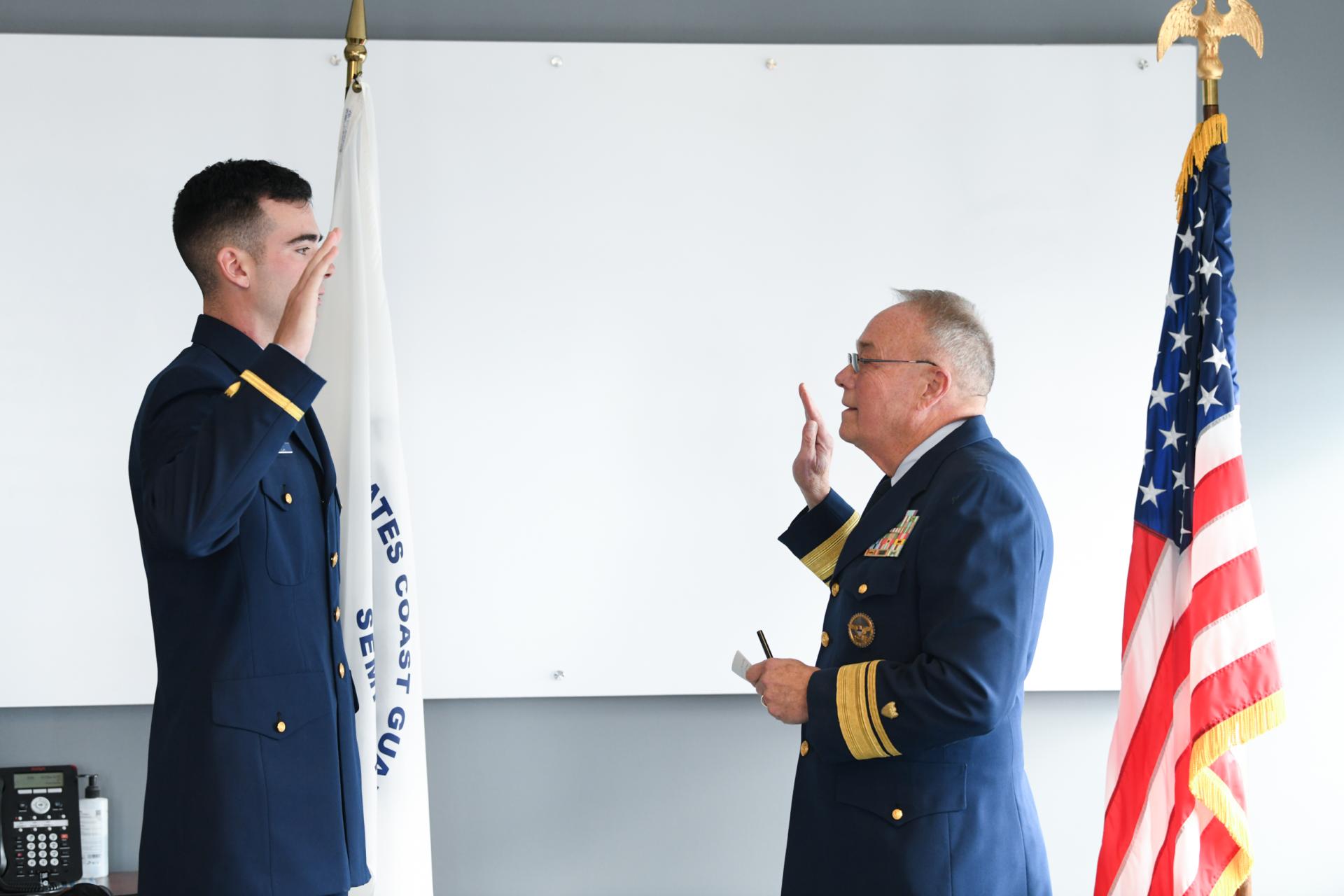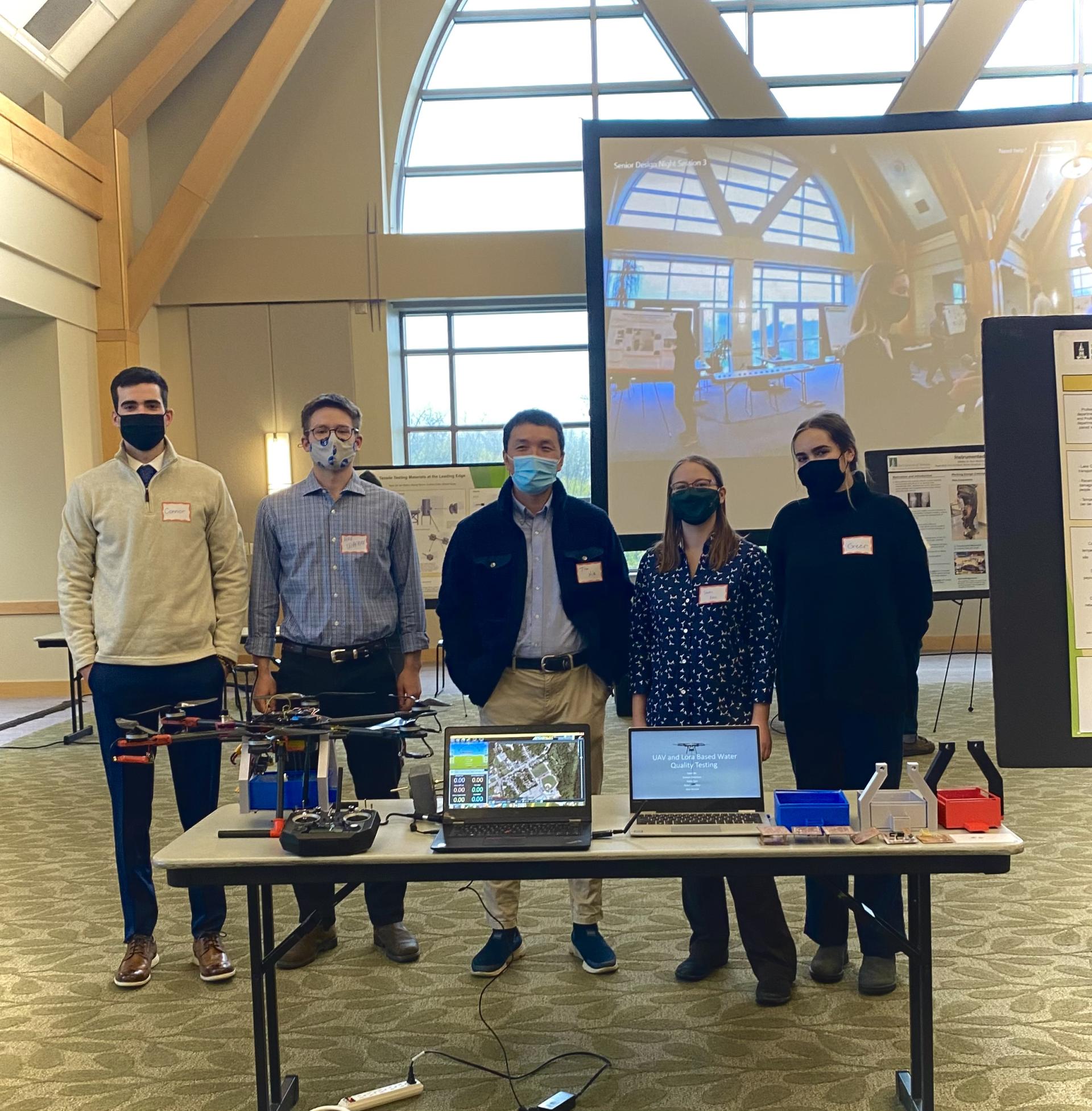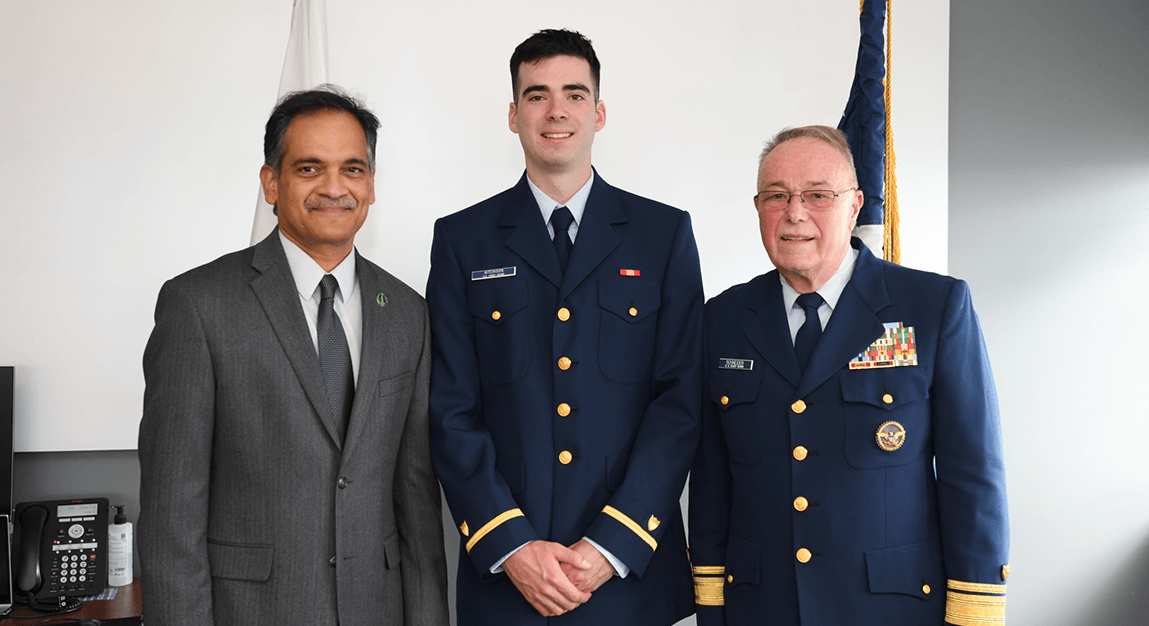When Connor Aitchison ’21, raised his hand to take the oath as an officer in the United States Coast Guard (USCG) on November 16, 2021, he was fulfilling a lifelong dream. “From a young age I always had a desire to serve in the military,” said the recent Mechanical Engineering graduate. “I just always saw serving your country as something very honorable and something I wanted to achieve.”
Aitchison’s desire to serve dovetails nicely with the growing need for engineers and computer scientists in the USCG and other branches of the military. “There are so many interesting and in-demand jobs right now and on the horizon,” said Rear Admiral (RADM) Richard W. Schneider USCGR (Ret), the person who administered Aitchison’s oath and who was president of Norwich University for over 25 years. “Technological advances, cyber-security threats, and border safety needs are creating many new opportunities in the Coast Guard.”

commissioned by RADM Schneider
Photo by David Seaver
So many opportunities, in fact, that the branch of the service that has evolved a lot throughout its long history made it possible for civilians and prior service members with a baccalaureate degree in a Science, Technology, Engineering, and Mathematics (STEM) or command, control, communications, computers, cyber, and information technology field to compete and apply for a commission through the Direct Commission Engineer (DCE) program, which expedites their training and puts their talents to specialized work.
Evolving with the Times
Founded in 1790, when Treasury Secretary Alexander Hamilton proposed to Congress the need for tariff patrol and collection along the new nation’s coasts, the “Revenue Cutter Service” was placed under the control of the Treasury Department to help ensure the burgeoning government’s finances. Until the re-establishment of the Navy in 1798, it was the only naval force in the early United States.
In 1915, the Revenue Cutter Service merged with the U.S. Life-Saving Service to become the modern-day Coast Guard. Placed under the U.S. Department of Homeland Security (DHS) in 2003 as part of legislation designed to more efficiently protect American interests following the terrorist attacks of September 11, 2001, the Coast Guard is the only branch of the United States Armed Forces that is not a part of the U.S. Department of Defense. Technically, it is both a federal law enforcement agency and military branch within the DHS.
Today, the nearly 50,000 members of the USCG perform multiple missions—from International Ice Patrol, fisheries law enforcement, marine environmental protection and safety, ports, waterways and coastal security, migration enforcement, drug interdiction, and search and rescue.
That varied task list sparked Aitchison’s interest. Indeed, it was more than just Aitchison’s love of being on the water that spurred him to look into the USCG. “I saw it as the most multi-mission focused branch,” he said. “We may not always be engaged in active wars, but our homeland always needs protection and our mariners will always need saving.”
Testing the Waters
“Before committing to a career,” Aitchison, who minored in pure mathematics, said, “I wanted to confirm that the Coast Guard was the right fit for me and I was right for the Coast Guard.” So he reached out to RADM Schneider to get perspective and dive deeper into questions.
“We had been in connection for over a year, as Connor was finishing his studies at UVM,” RADM Schneider said. “Connor was a wonderful student, and I also could tell that he was really a fine young person. USCG is very selective and I just knew he’d make a wonderful Guardsman.”
RADM Schneider connected Aitchison with Captain Eric Doucette of Coast Guard Sector Boston, who invited the then-UVM senior down to meet with him and his personnel. “My primary goal in visiting Boston,” Aitchison said, “was to learn more about the exciting career paths within the Coast Guard. But I also learned something more important through talking to each person. I asked each what their favorite aspect of their job was, and they unanimously answered, ‘the people we work with.’ The unanimity of their responses spoke volumes about the nature of the Coast Guard and the people that I strive to have the honor with whom I serve.”

Aitchison considers his time at UVM to have been tremendously beneficial for this next step. “My CEMS education prepared me in a multitude of ways,” he said. “From all the content I learned through an in-depth and wide course load, along with technical skills like Advanced SolidWorks, LaTeX, MATLAB programming, and all my professional skills—writing, speaking, presenting.” But he recognizes that it’s the people with whom he worked elevated his studies into a transformative educational experience. “I had a positive experience and enjoyed working with every professor I worked with during my time at UVM,” he said. “Anytime I had a question or needed help, each and every one went out of their way to help me.”
Support and Defend
RADM Schneider was not only delighted to help Aitchison through his decision process, he was honored to administer the oath to the new ensign. “To be asked to be someone’s commissioning officer is one of the best compliments,” he said. “When you commission them, a little piece of you goes with them—it is that important.” He added that, because less than 1% of Americans serve in the military (all branches), the oath to support and defend the Constitution of the United States feels that much more precious and momentous an undertaking.
At Burlington’s Coast Guard station—a busy place, despite its small size, because of its proximity to a national border—amidst some fellow UVM graduates, current students, his friends and family, and UVM president Suresh Garimella, Connor Aitchison took his oath. In his new role, he will bring his engineering expertise to care for the search and rescue boats that assist humans and marine life in the years to come.
President Garimella marked the importance of Aitchison’s accomplishments and bright future when he said, “Connor’s commitment to service and academic success represents the best of the University of Vermont, and we are proud of his decision to serve his country in the U.S. Coast Guard. It was moving to watch Connor take his oath with his family and friends gathered. As a fellow engineer and a fellow American, I wish Ensign Aitchison all the best in his Coast Guard career.”

